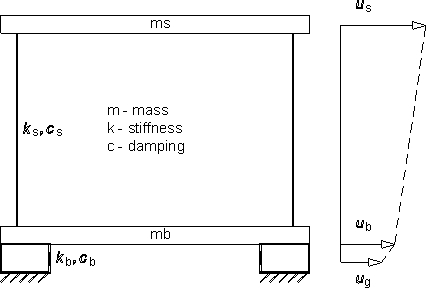
engineering & technology publications
ISSN 1759-3433
PROCEEDINGS OF THE EIGHTH INTERNATIONAL CONFERENCE ON COMPUTATIONAL STRUCTURES TECHNOLOGY
Seismic Behaviour of an Asymmetric Three-Dimensional Steel Frame with Base Isolation Devices
1Department of Civil Engineering, Faculty of Engineering (FEUP), University of Porto, Portugal
2Polytechnic Institute of Bragança, Portugal
The first approach in the analysis of structures with energy dissipation devices at the base is based on the use of a model with two degrees of freedom (DOF) (Figure 1): one DOF at the level of the base isolators; the second DOF at the floor level (Naeim and Kelly [2]).
A system of base isolation devices made of natural rubber guarantees a degree of damping in the order of 10-20% of the critical damping, considerably greater than structural damping factors for steel frames (in the order of 2%). The characteristics of the elastomer used in the BI devices are defined according to the recommendations of SETRA [3] and to the pre-norm pr EN 1337.
The parametric analysis is based on the variation of the structural elements
lengths (beam spans ![]() , and inter-story heights between floors
, and inter-story heights between floors ![]() ) and in the
definition of the space geometry (typology) of the asymmetric three-dimensional structure
represented in Figure 2 already used by the authors for characterizing its non-linear
carrying capacity (César and Barros [4]).
) and in the
definition of the space geometry (typology) of the asymmetric three-dimensional structure
represented in Figure 2 already used by the authors for characterizing its non-linear
carrying capacity (César and Barros [4]).
Qualitative and quantitative comparisons were made on akin variables (the total
acceleration and the relative lateral displacement of a top-floor node) for a set of
geometric-typological properties (![]() ,
, ![]() , typology) and for the three-dimensional asymmetric frame
modeled without and with elastomer isolators at the base of the columns (Barros and
César [1]). From the values obtained in the parametric study it is verified that the
behaviour of the asymmetric three-dimensional frame is altered when one to five floors of the rigid
slabs L2 and L3 exist; the most favourable effect (i.e. maximum decrease of total
acceleration) associated with the use of BI devices happens when three rigid slab floors
exist, for which the larger difference between the resultant total acceleration
without and with BI occurs . The resultant relative displacement stays practically constant
for corresponding cases of the parametric study, without and with the BI devices, with
respect to the number of rigid slab floors used (slabs L2 and L3).
, typology) and for the three-dimensional asymmetric frame
modeled without and with elastomer isolators at the base of the columns (Barros and
César [1]). From the values obtained in the parametric study it is verified that the
behaviour of the asymmetric three-dimensional frame is altered when one to five floors of the rigid
slabs L2 and L3 exist; the most favourable effect (i.e. maximum decrease of total
acceleration) associated with the use of BI devices happens when three rigid slab floors
exist, for which the larger difference between the resultant total acceleration
without and with BI occurs . The resultant relative displacement stays practically constant
for corresponding cases of the parametric study, without and with the BI devices, with
respect to the number of rigid slab floors used (slabs L2 and L3).
- 1
- Barros, R.C. and César, M.B., "A Parametric Study on the Seismic Behaviour of an Asymmetric Three-Dimensional Steel Frame with Base Isolation Devices", CONVIB Network Final Meeting, CD of Final Presentations and Conclusions, Ed.: L. Faravelli and F. Casciatti, University of Pavia, Italy, 2006.
- 2
- Naeim F. and Kelly J.M., Design of Seismic Isolated Structures: from theory to practice, John Wiley and Sons, New York, USA, 1999.
- 3
- SETRA, "Appareils d'appui en caoutchouc fretté: Utilisation sur les ponts, viaducs et structures similaires - Guide technique", Service d'Études Techniques des Routes et Autoroutes (SETRA), ref. 0032, France, 2000.
- 4
- César M.B. and Barros R.C., "Parametric Study of the Non-Linear Geometric Behaviour and Carrying Capacity of 3D Asymmetric Steel Frames", Civil Engineering Computing, Ed.: B.H.V. Topping, Paper 155, 17 pages, Civil-Comp Press, Scotland, U.K., 2005 (also submitted to Computers & Structures). doi:10.4203/ccp.81.155
purchase the full-text of this paper (price £20)
go to the previous paper
go to the next paper
return to the table of contents
return to the book description
purchase this book (price £140 +P&P)

